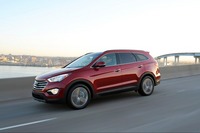2013 Hyundai Santa Fe Bigger, And Longer, Can be Better! By Thom Cannell
2013 Hyundai Santa Review
By Thom Cannell
Senior Editor
Michigan Bureau
The Auto Channel
Bigger, And Longer, Can be Better!
Santa Fe is Hyundai’s new entry into the three row family friendly CUV marketplace, replacing the Veracruz. Hyundai predicts this larger and longer Santa Fe will be popular with main stage families with children between Cub Scouts and mid-teen who need additional seating. Another factor is that many young couples can’t stand the necessity of a minivan, yet need capacity for toting troops of Brownies and hockey teams. As long as two or three of the passengers are children, Crossover Utility Vehicles are a growing answer.
We think Santa Fe’s appeal extends to post-family empty-nesters who will gravitate to it just as surely. We think that, although the Santa Fe Sport five passenger CUV may be more suitable for a sportier crowd or for those with fewer, or younger children, the longer wheelbase Santa Fe has additional room for suitcases and gardening supplies, antiques and wheelchairs for ailing family members. That should make Santa Fe a slam dunk for those who frequently depart chill Northern climates for sunny Florida.
 |
Another perspective, one based on economics is that if you're looking for a $40,000 three-row CUV but have only $29,000-$33,000 you won't feel disenfranchised. Compared to competitors like Honda Pilot, Toyota Highlander, or Nissan Pathfinder Hyundai offers more standard equipment at a price that is hundreds of dollars less.)
In our recent test—we exclusively drove the six passenger 2013 Hyundai Santa Fe Sport Limited—showed Santa Fe LWB to be as quiet as its sibling, making both luxury-car quiet and free from wind noise and other external disturbances. Exterior styling is distinctive, an exhibit of Hyundai’s third-generation of Fluidic Sculpture design and its powertrain is as sophisticated, and more powerful than a majority of competitors.
Because its price is lower than luxury brands many surfaces are not what they appear. The day is long gone when faux finishes look cheap, and Hyundai's wood offers a pleasing depth and sheen. The dash is covered in soft touch surfaces that are sometimes grained, sometimes presenting a woven linen-like surface. Even the "aluminum" door openers appear real, if a bit highly polished for our taste. Thoughtful extras include a large Volvo-like open sided bin beneath the center stack with 110V and two 12V outlets. It’s large enough for a clutch or belt bag, or gloves and sun glasses aplenty.
 |
Drivers will find just about every kind of control for the audio system, bluetooth telephone connection, and cruise control embedded into the wheel, and the steering effort is not only "perfect" but that perfection can be adjusted to three levels of resistance. Hyundai has its EPS or electrically controlled power steering very precisely controlled.
 |
 |
Hyundai designs and builds their own transmissions, this one a six-speed with a manual mode it calls SHIFTRONIC. Oddly we noted a very slight and occasional shift hesitancy, which we’ve never seen before. There’s also an “Active ECO” system; pushing a button smooths out throttle response and can increase real fuel economy by 5-7%, according to Hyundai.
Everyone overlooks brakes while car shopping, it just doesn't register compared to power, style, luxury, and features. But brakes are the primary safety feature, along with accurate steering. Santa Fe’s seven (including driver knee airbag) and safety belts are secondary systems. These brakes felt so good we didn’t notice them, a very good thing. Several hard stops in freeway traffic should have brought them to mind, but we just stopped. Part of their effectiveness is due to the 5,000 pound trailer rating as the vehicle supplies some or all the braking force for any trailer.
The last, optional, portion of the drive train is a torque vectoring control system with all wheel drive capacity. With less jargon, the AWD drive system supplied by Magna Powertrain uses data from all the onboard computers—transmission, engine, stability control, braking—to distribute torque to any wheel or wheels. Even shorter, it’s a transparent AWD system that makes driving safer, especially where ice, snow, and slick roads are an issue.
Ok, almost last as Hyundai also includes hill start assist and downhill brake assist. One makes it easier to slide your foot off the brake and onto the gas pedal, the other is a push-button answer to really steep downhill travel, particularly on dirt or gravel.
We did note a few chances for improvement, things you might not notice or completely disagree with, like a too-light door opening force on the rear doors and doors so well-hinged they feel light instead of sturdy. Another, and you'll have to be in direct sunlight and almost on your knees to see that the colors are not a perfect match and that the graining is subtly different where the upper dash surface swoops into the footwell."
Pricing starts at $28,350 for a base GLS FWD and tops out for a Limited AWD with every option at $37,750. There are only four option packages available, and they are model dependent. What’s not apparent is that Hyundai includes, on even base models, items like their 10 year/10,000 mile powertrain warranty with five years of roadside assistance, satellite radio, BlueLink telematics, stain-resistant seats, projector headlamps, downhill brake control, selectable steering feel, and many others where they are almost unique. And the pure cost saving ranges from $300 to $2,045 using their figures. Jump up to the top of the line Limited and the pure price proposition ranges from $146-$1750 while offering heated rear seats, standard second row captain’s chairs, exterior mirrors with built-in turn signals, and most of the previously mentioned items plus a 115V outlet, projector headlamps with LED accent, and 19” alloy wheels. You can try out Hyundai’s website to build your own, then check the competition.



